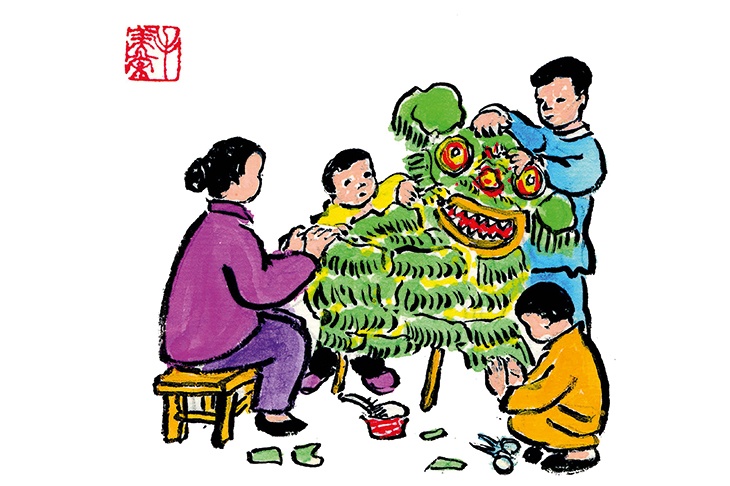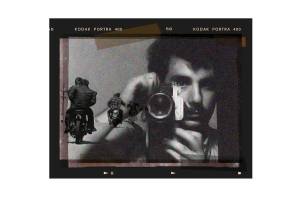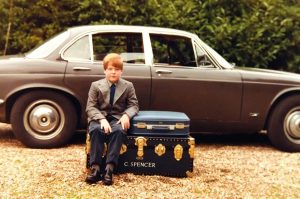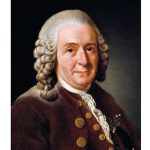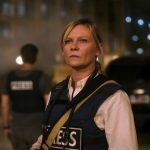Rao Pingru is 94, and a born storyteller. His gripping graphic narrative weaves in and out of the violent, disruptive upheavals that marked China’s transition in the 20th century from an immemorial, apparently immutable imperial past to its current uneasy truce with the technology, morals and politics of the Western world.
He was born in Nancheng, a city virtually unchanged in seven centuries since the end of the great Song dynasty. The first painting in this book shows Pingru himself as a small boy kneeling to knock his head on the floor in a traditional kowtow, performed at the foot of the man who had come to teach him to write. In ancient China, calligraphy embodied continuity, discipline, the accumulated wisdom of civilisation itself.
Pingru tells his story from the bottom up, so to speak, documenting a life lived against a background of constant chaotic destruction in small lively paintings that are hard to resist. He looks back to his grandfather, whom he never met, painting him in the voluminous yellow silk robes of a mandarin at the imperial court: a squat, almost square emblem of absolute power.
From the start Pingru pictures himself as a wide-eyed, owlish, bespectacled observer of the shifting contemporary scene. His father was a provincial lawyer, and he himself grew up in a society still regulated by the rhythm of seasonal street festivals, celebrated with feasting, fireworks and highly competitive homemade paper lanterns in the shape of dragons or lions.
He paints the house he lived in with its courtyards, Buddhist shrine and walled garden in a world where transport meant push-carts or carrying poles. He paints his parents’ rice bowls, which he had to fill at every meal. He paints the family at table, and the food he loved as a child: meatballs, mooncakes, glutinous rice dumplings and steamed rolls filled with sweet potato noodles. He even includes a diagram showing the correct ritual his mother taught him for washing his face.
But time was already up for the old traditional world he briefly glimpsed as a boy. He was five when the farmer’s son Mao Zedong recruited what he called his Red Army. And he was 12 when Mao embarked on the Long March that became the great founding myth of communist China. Open conflict between the advancing communists and the Nationalist Republican army of Chiang Kai-shek was postponed only when they joined forces in China’s war with Japan.
Pingru volunteered to fight for his country, presenting himself at 18 for military training. An uncharacteristically heroic image shows him mounted on a rearing war horse when he finally rode out to join the artillery in 1946. His regiment marched north into territory laid waste at intervals for 1,000 years by bandits, warlords and civil conflict. He describes the devastation he found there in a line from the 12th-century poet Jiang Kui: ‘Abandoned ponds and lofty trees still detest talk of soldiers.’
The civil war had started again, ending in 1949 with triumph for Mao, who declared the People’s Republic of China. Pingru’s problem was that he had enlisted three years earlier in what was then the victorious Nationalist army. It turned out to be a disastrous choice. He and his family were ostracised, stigmatised and punished for it to the end of their lives. Nothing they could do altered the fact that an initial mistake had marked them for ever in communist China as class enemies.
A new society remodelled for a new world meant the start of a new life. Pingru had fallen in love at first sight with a 19-year-old girl called Mao Meitang, who married him in 1948. Together they opened a shop selling noodles that closed almost at once. A second attempt to start a business trading in chillis also ended in dismal failure. Eventually Pingru got a job in Shanghai, working as an accountant to support his wife and their growing family in Nancheng.
In 1958 Mao’s second Five Year Plan plunged China into starvation. Around 40 million people died in the great famine. Pingru spent 22 years in a forced labour camp. He says relatively little about the ‘Re-education through labour’ that swallowed the two central decades of his adult life, leaving Meitang responsible for their children’s survival, upbringing and education. The wife of an enemy of the people ranked bottom of the social heap, so the only work she could find was carrying bags of cement (each weighing more than four stone, or 25 kilos) as a labourer on construction sites. Her eldest son, who was nine, shifted scrap iron.
Pingru would be nearly 60 before he was free to go home after Mao’s death. He expresses his satisfaction with a painting of the whole family sitting round a bare wooden table eating their fill of steamed dumplings. But grief, hardship and physical exertion had worn his wife out. She died slowly and painfully of kidney failure less than ten years after his release.
This book is his tribute to her in words and pictures, both entirely free from resentment or anger. Pingru survived almost unimaginable privation thanks primarily to an insatiable interest in other people, an absolute lack of self-pity and a curiosity that nothing could extinguish. He retains in his nineties something of the bright, energetic, observant small boy who learned to write, draw and make lanterns in the traditional way. One of the last paintings in his book is a self-portrait that shows him as a white-haired grandfather, squatting on a low wooden stool in T-shirt, shorts and flip-flops playing the mouth organ to his cat.
This book emerges from communist China with no word of explanation, no blurb, preface or dustjacket, and no proper cover to the spine. Although it was translated with Arts Council funding and put out by an offshoot of Penguin, it shows little sign of even perfunctory editing. But thanks to the persuasive power of its humane and humorous author, Our Story is as hard to resist as the great, rich, rambling serial narratives of the oral storytellers who travelled from one Chinese village to another in the past, drawing entire populations out of their houses to sit on the hillside and listen.
